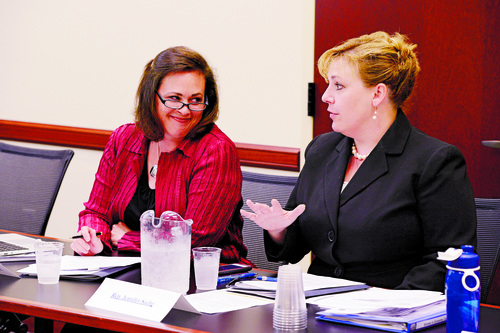This is an archived article that was published on sltrib.com in 2014, and information in the article may be outdated. It is provided only for personal research purposes and may not be reprinted.
How can Utah shrink what is one of the largest wage gaps in the country — women here earn 30 percent less than men?
On Monday, the Women in the Economy Commission met for the first time seeking answers to that age-old conundrum that often leaves women and children in or near poverty.
Young women may seek lower-paying jobs because they lack mentors.
Women who marry early may lack the educational opportunities of their male counterparts in the workforce. Women who rear children leave and rejoin the job market often without advancement. Homemakers who divorce may lack work experience. Not least, women suffer discrimination in the workplace.
"Women in Utah need to have educational and occupational choices to close the wage gap," said Lecia Parks Langston, economist for the Utah Department of Workforce Services.
But how to get from here to there?
That's what the 11-member, all-female commission is seeking to do, said Rep. Jennifer Seelig, D-Salt Lake City, who sponsored the legislation that created the body earlier this year.
Seelig and House Speaker Becky Lockhart, R-Provo, were elected co-chairwomen Monday.
Both will leave the Legislature — and the commission — at year's end. They promised results before their terms expire.
Among its first moves, the commission, also comprised of business people, academicians and service providers, will "determine the landscape — the reality of women's lives in the economy," Seelig said.
Some important factors of that landscape are: Utah women marry young; Utahns have large families; and the state's divorce rate measures consistently higher than the U.S. average, Langston said.
Those are among the reasons for the $14,478 wage gap in Utah. The median wage for men is $48,540. For women, it's $34,062, according to the Department of Workforce Services.
That means that women earn 70 cents for every dollar earned by their male counterparts.
Nationally, women make 79 cents on the dollar.
"Utah has one of the largest wage gaps in the country," Langston said.
The commission also wants to identify public and private programs that can help women, Seelig said, and make that information readily available.
"Once they make an occupational choice, how do we make sure they have all the tools to succeed?" Seelig said. "We need to identify the tools women need to get the occupation they choose."
Workforce Services has programs that can help women prepare for and enter the job market, said Amber Johnston, project manager, Work Ready Initiatives.
Young women ages 14 to 21 may qualify for the Workforce Investment Act that provides tutoring and alternative schools, as well as occupational-skills training and internships, Johnston said.
The act also provides job training for workers who have been laid off and military personnel returning to the labor market.
Johnston noted that Workforce Services offers online and in-person employment workshops on such things as job searches, résumé building, job interviews and basic computer skills.
Not least, she said, women should know they can seek help when they find themselves in economic crisis. Workforce Services' programs include unemployment insurance, Medicaid, Children's Health Insurance Program, food stamps and child-care assistance, among others.
The committee is still conceptualizing its goals, Seelig said, but young women need mentors to see possibilities and the belief that they can earn the credentials for success.
In the coming months, the committee will seek information and advice from all sectors, Seelig said.
"We need the voices of all members of our community if we are to remain competitive in the [national] economy," she said. "I think we will have a tremendous amount of traction. Women are asking for more."
For more information, contact jseelig@le.utah.gov.
Utah wage gap
Median male income • $48,540
Median female income • $34,062
—
Women make up 44.4 percent of workforce but hold 65 percent of low-wage jobs.
—
Utah women earn 70 cents for every $1 made by a male.
Nationally, women earn 79 cents per $1 made by a male
Sources: Utah Department of Workforce Services and National Women's Law Center





